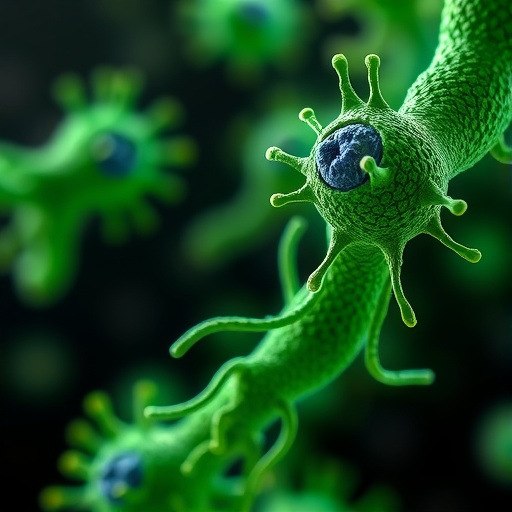
In the world of bacterial cell division, a crucial player is the tubulin-like protein FtsZ. This protein is essential for cytokinesisâthe process by which a single cell divides into two daughter cells. Recent research led by Singh et al. has unveiled new insights into the inhibition of FtsZ-driven bacterial cytokinesis using natural products. The study employs a novel integration of machine learning techniques, aimed at advancing drug discovery, particularly in the effort to combat antibiotic resistance.
FtsZ operates as a pivotal component of the bacterial cytoskeleton, forming a contractile ring at the future division site. Understanding how we can disrupt this process is vital, particularly given the rise of multidrug-resistant bacterial strains. The teamâs work suggests that a variety of natural compounds could be deployed to thwart the function of FtsZ, thereby halting bacterial replication.
The study employed a multidisciplinary approach, combining biochemistry, pharmacology, and computational biology. By using machine learning algorithms, the researchers were able to analyze a vast database of natural products to identify potential inhibitory candidates against FtsZ. This integrated method not only enhances the efficiency of drug discovery but also allows for the prediction of how these compounds might interact with biological targets at a molecular level.
Initial results indicate that certain flavonoids and alkaloids show a promising impact on FtsZ activity. These compounds, typically found in plants, have been historically noted for their antibacterial properties. By refining their structures through computational modeling, Singh et al. were able to enhance their efficacy further, leading to a new understanding of how small molecular changes can influence biological activity.
The efficacy of these natural products was tested in vitro, providing compelling evidence of their potential relevance in clinical settings. The researchers observed that treating bacterial cultures with these inhibitors significantly reduced the formation of the FtsZ ring, leading to cell division failure. This approach is particularly timely as it presents a novel strategy to avert cell division in pathogenic bacteria.
Importantly, the researchers also evaluated the cytotoxicity of the identified compounds. This is a key step in drug development since the ideal antimicrobial agents need to selectively target bacterial cells while sparing human cells. Preliminary findings suggest that some compounds can effectively inhibit bacterial growth without adversely affecting human cells, providing a dual advantage of efficacy and safety.
Moreover, the vast dataset and computational tools utilized in the study offer a pathway to identify additional natural products that could inhibit FtsZ. This has the potential to usher in a new era of antibiotic development by discovering substances already present in nature that humans have yet to fully exploit.
This significant research not only paves the way for new therapies but also directs attention towards the importance of natural product chemistry in combating resistant bacterial strains. Singh et al. are now poised to take their discoveries to the next level: exploring how these natural compounds function at a molecular level to understand better how FtsZ inhibition occurs.
As antibiotic resistance becomes an ever-growing concern in global health, findings like these highlight the urgency for innovative therapeutic strategies. The global medical community is facing a pressing challenge, and natural products may hold the key to unlocking new solutions.
By developing a deeper understanding of FtsZ and its interactions with various natural compounds, researchers can potentially formulate more effective treatments against bacterial infections. This study contributes vital knowledge to a relatively underexplored area, emphasizing the role of interdisciplinary collaboration in overcoming significant medical obstacles.
In addition, Singh et al. are advocating for a broader exploration of natural products beyond traditional antibacterial candidates. Many well-known therapeutic agents originate from natural sources, indicating a wealth of untapped potential lying within our ecosystems. The team urges further investments in bioprospecting and the utilization of advanced computational methods to accelerate the discovery of novel antimicrobials.
Success in this arena could represent a formidable step against antibiotic resistance, rekindling faith in our ability to combat bacterial infections effectively. As the research community continues to strive for efficient models of drug development, studies like this provide both the proof-of-concept and the framework needed for future endeavors.
In summary, the work spearheaded by Singh et al. emerges as a promising advancement in our understanding of bacterial cytokinesis and the search for novel antibacterial agents. Their integration of machine learning with traditional natural product screening could not only accelerate the discovery of new drugs but also reshape the frontiers of microbiology and pharmacology in the face of looming public health threats.
Through continuing this dialogue and investing in such groundbreaking research, we can aspire to meet and overcome the challenges posed by resistant bacterial pathogens. As we embark on this exciting journey of scientific exploration and discovery, the potential for impactful breakthroughs in antibiotic development grows larger with every study.
Subject of Research: Mechanistic inhibition of FtsZ-driven bacterial cytokinesis by natural products.
Article Title: Mechanistic inhibition of FtsZ-driven bacterial cytokinesis by natural products: an integrated machine learning and advanced drug discovery approach.
Article References:
Singh, R., Tripathi, V., Dwivedi, V.D. et al. Mechanistic inhibition of FtsZ-driven bacterial cytokinesis by natural products: an integrated machine learning and advanced drug discovery approach.
Mol Divers (2025). https://doi.org/10.1007/s11030-025-11332-1
Image Credits: AI Generated
DOI: 10.1007/s11030-025-11332-1
Keywords: FtsZ, bacterial cytokinesis, natural products, machine learning, drug discovery, antibiotic resistance, flavonoids, alkaloids, biochemistry, pharmacology.
Tags: antibiotic resistance strategiesbacterial cell divisionbacterial cytoskeleton researchbiochemistry and pharmacology integrationcomputational biology applicationscytokinesis disruption methodsFtsZ protein inhibitioninnovative drug development techniquesmachine learning in pharmacologymultidrug-resistant bacteria solutionsnatural compounds against bacterianatural product drug discovery




